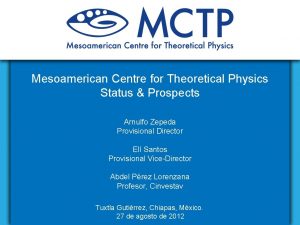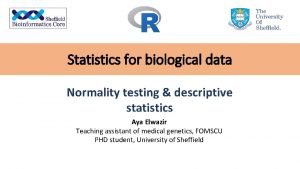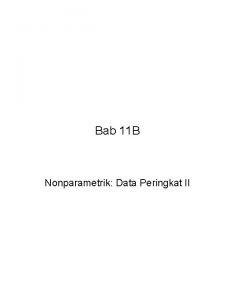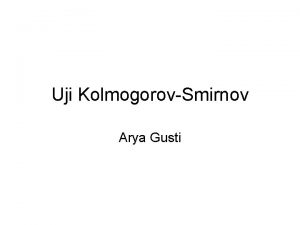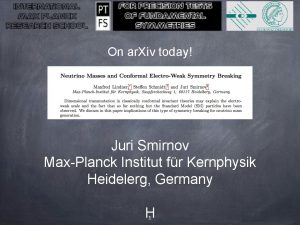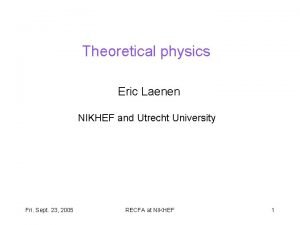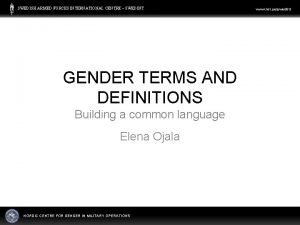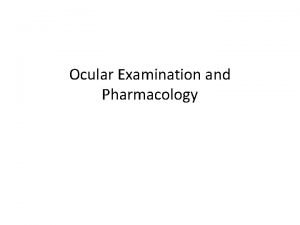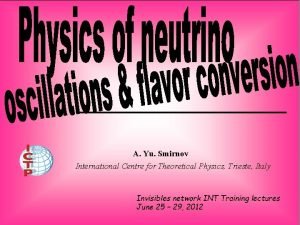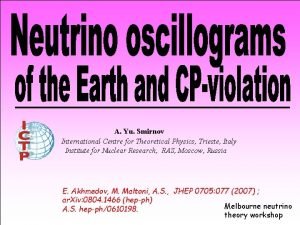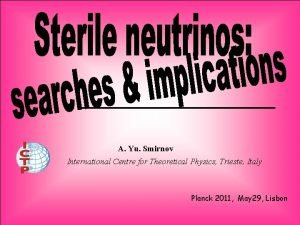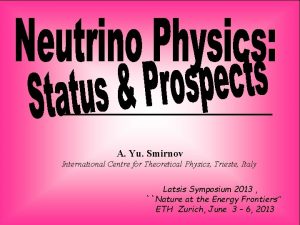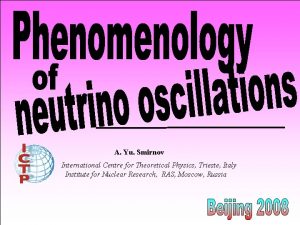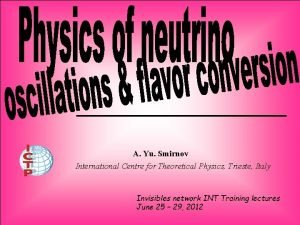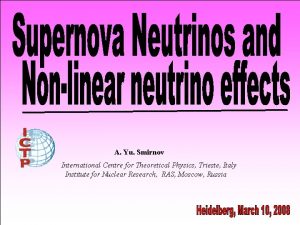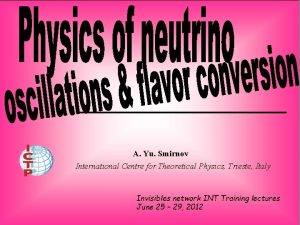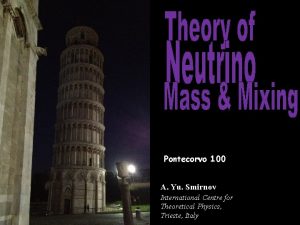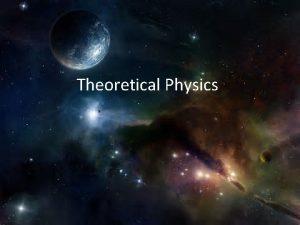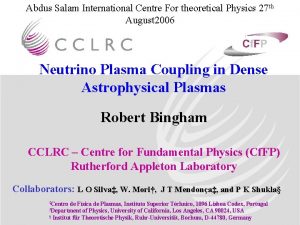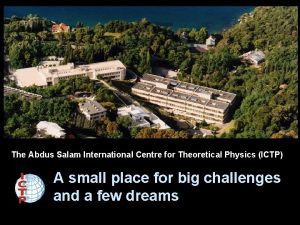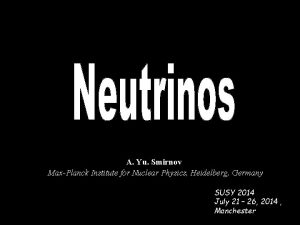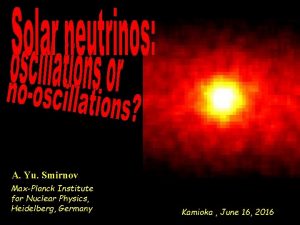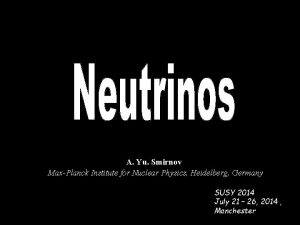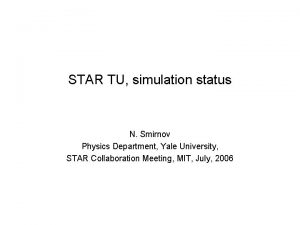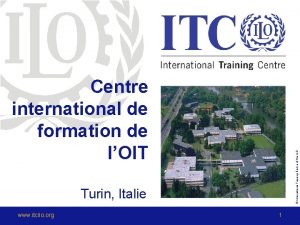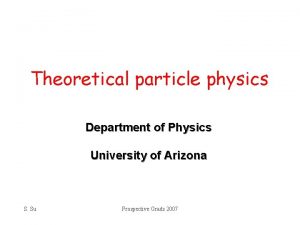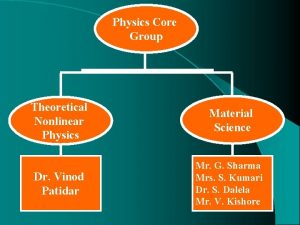A Yu Smirnov International Centre for Theoretical Physics








































- Slides: 40

A. Yu. Smirnov International Centre for Theoretical Physics, Trieste, Italy Institute for Nuclear Research, RAS, Moscow, Russia NO-VE 2006: ``Ultimate Goals’’

Two fundamental issues

Mixing Quarks Leptons 1 -2, q 12 13 o 34 o 2 -3, q 23 2. 3 o 45 o 1 -3, q 13 ~ 0. 5 o <10 o Hierarchy of masses: Neutrinos |m 2 /m 3| ~ 0. 2 Charged |m m/mt| = 0. 06 leptons Down |ms /mb| ~ 0. 02 - 0. 03 quarks Up-quarks |mc /mt| ~ 0. 005 2 -3 1 -2 1 s 1 -3 0 0. 2 0. 4 0. 6 |sin q| 0. 8

1 up quarks 10 -1 down quarks charged leptons neutrinos Regularities? mu mt = m c 2 10 -2 Vus Vcb ~ Vub 10 -3 Koide relation 10 -4 10 -5 at m. Z

Can both features be accidental? Neutrino mass matrix in the flavor basis: For charged leptons: D = 0 A B B C D D C nm - nt permutation symmetry Often related to equality of neutrino masses Discrete symmetries S 3, D 4 Can this symmetry be extended to quark sector? Are quarks and leptons fundamentally different?

A. Joshipura, hep-ph/0512252 2 -3 symmetry Maximal (large) 2 -3 leptonic mixing Smallness of Vcb Universal mass matrices 2 -3 symmetry Does not contradict mass hierarchy X AA A B C A C B + dm Quarks, charged leptons: B ~ C, X << A << B Neutrinos: B >> C, X ~ B - Hierarchical mass spectrum - Small quark mixing - Degenerate neutrino mass spectrum; - Large lepton mixing additional symmetries are needed to explain hierarchies/equalities of parameters

nm - nt permutation symmetry A B B C D D C Matrix for the best fit values of parameters (in me. V) 3. 2 6. 0 24. 8 0. 6 21. 4 30. 7 sin 2 q 13 = 0. 01 sin 2 q 23 = 0. 43 Bari group Substantial deviation from symmetric structure Structure of mass matrix is sensitive to small deviations Of 1 -3 mixing from zero and 2 -3 mixing from maximal

Similar gauge structure, correspondence Very different mass and mixing patterns Particular symmetries in leptonic (neutrino) sector? Q-L complementarity? Symmetry correspondence re u t c ru ces t u s d l na pro o i t i h Add s whic ce. t n Is this seesaw? exis iffere d Something beyond seesaw? the

Neutrality Qg = 0 Qc = 0 Majorana masses Basis of seesaw mechanism mix with singlets of the SM Dynamical effects Is this enough to explain all salient properties of neutrinos?

Window to hidden world? Standard Model s nl l l. R H s A S A L . . . n. R S . . . M S Planck scale physics

Screening of the Dirac structure Induced effects of new neutrino states

ur , ub , uj <-> n dr , db , dj <-> e Correspondence: color Symmetry: Leptons as Unification: Can it be accidental? 4 th color Pati-Salam form multiplet of the extended gauge group, in particular, 16 -plet of SO(10) More complicated connection between quarks and leptons? Complementarity?

generically Provide with all the ingredients necessary for seesaw mechanism Give relations between masses of leptons and quarks mb = mt In general: ``sum rules’’ RH neutrino components Large mass scale Lepton number violation b - t unification large 2 -3 leptonic mixing But - no explanation of the flavor structure


approximate I. Dorsner, A. S. NPB 698 386 (2004) is realized in terms of the mass matrices (matrices of the Yukawa couplings) and not in terms of observables – mass ratios and mixing angles. di Eigenvalues = masses io at liz na o ag Mass matrices M=YV Eigenstates = mixing n Universal structure for mass matrices of all quarks and leptons in the lowest approximation: Small perturbations: YU = YD = Yn. D = YL = Y 0 Yf = Y 0 + DYf ( Y 0)ij >> (DYf)ij f = u, d, L, D, M

Important example: Y 0 = l 4 l 3 l 2 l 1 l ~ 0. 2 - 0. 3 Unstable with respect to small perturbations Yfij = Y 0 ij (1 + efij) Universal singular Small perturbations allow to explain large difference in mass hierarchies and mixings of quarks and leptons f = u, d, e, n Perturbations e ~ 0. 2 – 0. 3 Form of perturbations is crucial

Seesaw: m ~ 1/M Nearly singular matrix of RH neutrinos leads to - enhancement of lepton mixing - flip of the sign of mixing angle, so that the angles from the charged leptons and neutrinos sum up

In some (universality) basis in the first approximation all the mass matrices but Ml (for the charged leptons) are diagonalized by the same matrix V: For the charged leptons, the mass is diagonalized by V* Diagonalization: V for V* for u, d, n l In the first approximation Quark mixing: Lepton mixing: VCKM = V+ V = I VPMNS = VT V A Joshipura, A. S. hep-ph/0512024 V + M f V = Df VT M l V * = D l Ml = Md T SU(5) type relation Another version is when neutrinos have distinguished rotation: V for u, d, l V* for n

In general, up and down fermions can be diagonalized by different matrices V’ and V respectively VCKM = V’+ V VPMNS = VT V’ VPMNS = VTV VCKM+ = V 0 PMNS VCKM + VPMNS VCKM = VTV V 0 PMNS = VTV VPMNS (with CKM corr. ) Quark and lepton rotations are complementary to VVT - symmetric, characterized by 2 angles; - close to the observed mixing for q/2 ~ f ~ 20 – 25 o - 1 -3 mixing near the upper bound - gives very good description of data - predicts sin q 13 > 0. 08

Universal mixing and universal matrices Mu, n ~ m D* A D* Md ~ m D*A D D = diag(1, i, 1) A~ e 12 e 22. . . Ml ~ m D A D * A is the universal matrix: e 12 e 1 e 2 e 1 1 ei ~ 0. 2 – 0. 3 Can be embedded in to SU(5) and SO(10) with additional assumptions


ql ql 12 23 + qq 12 ~ 23 p/4 ~ p/4 qsol + q. C = 46. 7 o +/- 2. 4 o A. S. M. Raidal H. Minakata qatm + V cb = 45 o +/- 3 o 1 s Difficult to expects exact equalities but qualitatively 2 -3 leptonic mixing is close to maximal because 2 -3 quark mixing is small 1 -2 leptonic mixing deviates from maximal substantially because 1 -2 quark mixing is relatively large H. Minakata, A. S. Phys. Rev. D 70: 073009 (2004) [hep-ph/0405088]

``Lepton mixing = bi-maximal mixing – quark mixing’’ Quark-lepton symmetry Existence of structure which produces bi-maximal mixing Mixing matrix weakly depends on mass eigenvalues In the lowest approximation: Vquarks = I, Vleptons =Vbm m 1 = m 2 = 0 sin q. C = 0. 22 as ``quantum’’ of flavor physics sinq. C = mm /mt sinq. C ~ sin q 13 Appears in different places of theory

F. Vissani V. Barger et al Ubm = U 23 m. U 12 m Two maximal rotations Ubm = ½ ½ 0 -½ ½ UPMNS = Ubm - maximal 2 -3 mixing - zero 1 -3 mixing - maximal 1 -2 mixing - no CP-violation In the lowest order? Corrections? As dominant structure? Zero order? Contradicts data at (5 -6)s level UPMNS = U’ Ubm U’ = U 12(a) Generates simultaneously Deviation of 1 -2 mixing from maximal Non-zero 1 -3 mixing

H. Minakata, A. S. R. Mohapatra, P. Frampton, C. W. Kim et al. , S. Pakvasa … QLC-1 Charged leptons Neutrinos sinq 12 = sinq 13 = QLC-2 CKM mixing ml ~ md q-l symmetry Maximal mixing m. DT M-1 m. D sin(p/4 - q. C) + 0. 5 sin q. C( 2 - 1) tan 2 q 12 = 0. 495 sin q. C/ 2 Maximal mixing CKM mixing m. D ~ mu q-l symmetry sin(p/4 - q. C) ~ Vub

Utbm = Utm Um 13 UQLC 1 = UC Ubm Give the almost same 12 mixing coincidence QLC 2 QLC 1 tbm 3 s 2 s 1 s SNO (2 n) Strumia-Vissani 99% 90% Fogli et al 29 31 33 3 n - analysis does change bft but error bars become smaller 35 37 39 q 12 + q. C ~ p/4 q 12

L. Wolfenstein P. F. Harrison D. H. Perkins W. G. Scott Utbm = U 23(p/4)U 12 Utbm = 2/3 1/3 - 1/6 1/3 1/6 - 1/3 - maximal 2 -3 mixing - zero 1 -3 mixing - no CP-violation 0 1/2 n 3 is bi-maximally mixed n 2 is tri-maximally mixed sin 2 q 12 = 1/3 in agreement with 0. 315 Mixing parameters - some simple numbers 0, 1/3, 1/2 Relation to group matrices? S 3 group matrix In flavor basis… relation to masses? No analogy in the Quark sector? Implies non-abelian symmetry

In agreement with 0 value T 2 K Double CHOOZ Dm 212/Dm 322 QLC 1 q. C 99% Strumia-Vissani 90% 3 s 2 s 1 s 0 0. 01 0. 02 0. 03 0. 04 0. 05 Fogli et al sin 2 q 13 Non-zero central value (Fogli, et al): Atmospheric neutrinos, SK spectrum of multi-Ge. V e-like events Lower theoretical bounds: Planck scale effects RGE- effects V. S. Berezinsky F. Vissani M. Lindner et al

1). Superheavy MS >> v. EW - decouple 2). Heavy: v. EW >> m. S >> mn 3). Light: m. S ~ mn play role in dynamics of oscillations

Double (cascade) seesaw m= 0 m. D T 0 m. D 0 0 M DT M D MS n N S MR = - MDT MS-1 MD mn = m. D MD-1 MS MD-1 m. D If MD = A-1 m. D mn = A 2 M S Additional fermions m. D << MS M. Lindner M. Schmidt A. S. JHEP 0507, 048 (2005) R. Mohapatra PRL 56, 561, (1986) R. Mohapatra. J. Valle MS – Majorana mass matrix of new fermions S A ~ v. EW/MGU A. S. PRD 48, 3264 (1993) m. D similar (equal) to quark mass matrix - cancels Structure of the neutrino mass matrix is determined by M S -> physics at highest (Planck? ) scale immediately

Reconciling Q-L symmetry and different mixings of quarks and leptons Seesaw provides scale and not the flavor structure of neutrino mass matrix Structure of the neutrino mass matrix is determined by MS origin of ``neutrino’’ symmetry MS ~ MPl ? leads to quasi-degenerate spectrum if e. g. MS ~ I, origin of maximal (or bi-maximal) mixing Q-l complementarity

Mixing with sterile states change structure of the mass matrix of active neutrinos Active neutrinos acquire (e. g. via seesaw) the Majorana mass matrix ma Consider one state S which has - Majorana mass M and - mixing masses with active neutrinos, mi. S (i = e, m, t) After decoupling of S the active neutrino mass matrix becomes (mn)ij = (ma )ij - mi. Smj. S/M induced mass matrix sinq. S = m. S/M mind = sinq. S 2 M

mind = sinq. S 2 M > 0. 02 – 0. 03 e. V sinq. S 2 M ~ 0. 003 e. V sinq. S 2 M < 0. 001 e. V Induced matrix can reproduce the following structures of the active neutrino mass Dominant structures for normal and inverted hierarchy Sub-leading structures for normal hierarchy Effect is negligible

In the case of normal mass hierarchy 1 mtbm ~ m 2/3 1 1 1 1 + m 3/2 0 0 0 1 -1 -1 1 m 2 = Dmsol 2 Assume the coupling of S with active neutrinos is flavor blind (universal): mi. S = m 2 /3 Then mind can reproduce the first matrix mtbm = ma + mind ma is the second matrix Two sterile neutrinos can reproduce whole tbm-matrix

R. Zukanovic-Funcal, A. S. in preparation Two regions are allowed: MS ~ 0. 1 – 1 e. V and MS > (0. 1 – 1) Ge. V

Q & L: - strong difference of mass and mixing pattern; - possible presence of the special leptonic (neutrino) symmetries; - quark-lepton complementarity This may indicate that q & l are fundamentally different or some new structure of theory exists (beyond seesaw) Still approximate quarks and leptons universality can be realized. Mixing with new neutrino states can play the role of this additional structure: - screening of the Dirac structure - induced matrix with certain symmetries.

SK (3 n) - no shift from maximal mixing sin 22 q 23 > 0. 93, 90% C. L. T 2 K QLC 1 3 s 2 s 1 s 90% maximal mixing QLC 2 SK (3 n) Gonzalez-Garcia, Maltoni, A. S. Fogli et al 0. 2 0. 3 0. 4 0. 5 0. 6 0. 7 sin 2 q 23 1). in agreement with maximal 2). shift of the bfp from maximal is small 3). still large deviation is allowed: (0. 5 - sin 2 q 23)/sin q 23 ~ 40% 2 s

R. Zukanovic-Funcal, A. S. in preparation


Possibility that their properties are related to very high scale physics Smallness of mass Large mixing Violate fundamental symmetries, Lorentz inv. CPT, Pauli principle? Can propagate in extra dimensions Manifestations of non- QFT features?
 Mesoamerican center for theoretical physics
Mesoamerican center for theoretical physics Apa itu uji normalitas
Apa itu uji normalitas Kolmogorov-smirnov test for normality
Kolmogorov-smirnov test for normality Tabel kolmogorov smirnov
Tabel kolmogorov smirnov Tabel kolmogorov smirnov
Tabel kolmogorov smirnov Pengertian uji kolmogorov smirnov
Pengertian uji kolmogorov smirnov Juri smirnov
Juri smirnov Ebook central perpetual, dda and subscription titles
Ebook central perpetual, dda and subscription titles Nikhef theory
Nikhef theory Theoretical foundation of international business
Theoretical foundation of international business Centroid engineering
Centroid engineering Center of gravity
Center of gravity International training centre of the ilo torino
International training centre of the ilo torino International training center ilo
International training center ilo Adfelps test online
Adfelps test online [email protected]
[email protected] International geneva welcome centre
International geneva welcome centre International computing centre
International computing centre Nordic center for gender in military operations
Nordic center for gender in military operations International pharmacovigilance centre
International pharmacovigilance centre Who programme for international drug monitoring
Who programme for international drug monitoring International centre for eye health
International centre for eye health Modern physics vs classical physics
Modern physics vs classical physics University physics with modern physics fifteenth edition
University physics with modern physics fifteenth edition Physics ia format
Physics ia format Fspos vägledning för kontinuitetshantering
Fspos vägledning för kontinuitetshantering Typiska novell drag
Typiska novell drag Tack för att ni lyssnade bild
Tack för att ni lyssnade bild Vad står k.r.å.k.a.n för
Vad står k.r.å.k.a.n för Varför kallas perioden 1918-1939 för mellankrigstiden
Varför kallas perioden 1918-1939 för mellankrigstiden En lathund för arbete med kontinuitetshantering
En lathund för arbete med kontinuitetshantering Personalliggare bygg undantag
Personalliggare bygg undantag Tidbok för yrkesförare
Tidbok för yrkesförare Sura för anatom
Sura för anatom Förklara densitet för barn
Förklara densitet för barn Datorkunskap för nybörjare
Datorkunskap för nybörjare Tack för att ni lyssnade bild
Tack för att ni lyssnade bild Debattartikel struktur
Debattartikel struktur För och nackdelar med firo
För och nackdelar med firo Nyckelkompetenser för livslångt lärande
Nyckelkompetenser för livslångt lärande Påbyggnader för flakfordon
Påbyggnader för flakfordon
